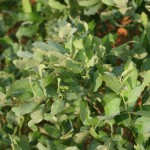Sand shinnery oak, Havard shinoak
Quercus havardii Rydb.
Fagaceae (Beech family)
Description
Sand shinnery oak is a low, shrubby tree of the Beech family. It rarely reaches more than 3 feet tall. Because of their aggressive underground rhizomes, these trees can form dense thickets over large areas and in deep sands.
The leaves are deciduous and located alternately along the stems. The leaves have a leathery, rough texture and pointed lobes.
Sand shinnery oaks produce typical oak-type acorn fruit. Produced annually in the spring, the acorns of this tree are rather large, ranging from 1/2 to 1 inch long and 1/2 to 5/8 inch wide.
The tree may hybridize with other shin oak and live oak species.
The young stems and acorns are poisonous to livestock and the plant provides fair forage for wildlife.
Habitat
Sand shinnery oak grows in deep, sandy soils in the western part of Texas, including the lower Panhandle, Permian Basin and Trans-Pecos regions.
Images
Plant Characteristics
Seed Type: Nut/Acorn
Duration: Perennial
Stem Texture: Hairless/Smooth
Growth Habit: Shrub (Woody)
Leaf Shape
 : Simple with Pinnate or Parallel Venation
: Simple with Pinnate or Parallel Venation
Season: Warm
Distribution
 : 07 - Edwards Plateau, 08 - Rolling Plains, 09 - High Plains, 10 - Trans-Pecos
: 07 - Edwards Plateau, 08 - Rolling Plains, 09 - High Plains, 10 - Trans-Pecos
Distributions
Distribution refers to the ecological region in Texas that a plant has been found. You can also view a clickable map.
Book: Brush and Weeds of Texas Rangelands (B-6208)
Collection: Brush and Weeds






